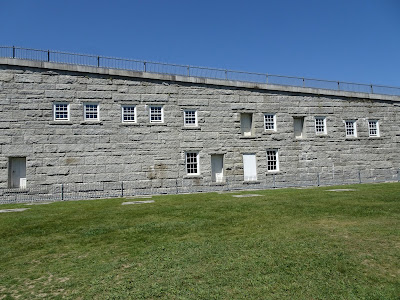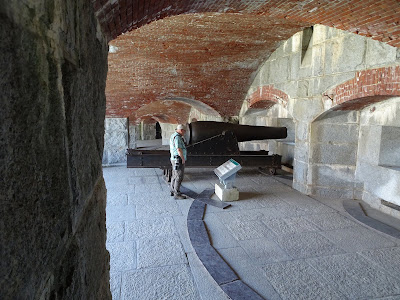View of Fort Knox from inside the Penobscot Narrows
Bridge Observatory.
You can buy a combination ticket for the observatory and
the Fort ($8 for non-resident. We weren’t
old enough for the senior discount).
Built between 1844 and 1869, it was the first fort in
Maine built entirely of granite.
It is named after Major General Henry Knox, the first
U.S. Secretary of War and Commander of Artillery during the American
Revolutionary War.
Fort Knox never saw battle, though it was manned during times
of war.
During the American Civil War volunteers from Maine,
mostly recruits in training before assignment to active duty, manned the fort.
Located on the west bank of the Penobscot River in Prospect,
Maine, in an area known as the Penobscot Narrows, Fort Knox is one of the
best-preserved military fortifications on the New England seacoast.
In 1923, the federal government declared the fort excess
property and put its 125-acre grounds up for sale. The state of Maine bought it
for $2,121. It has been administered as
a Maine state historic site since 1943.
The fort is one of the best-preserved and most accessible
forts in the United States. All of the fort is open to the public.
Several period weapons are on site, including two
15-inch Rodman Smoothbores and a 10-inch Rodman Smoothbore.
A 10-inch Rodman smoothbore
Hot shot furnace.
Keeping gunpowder dry and safe from flame was critical to
the safety and function of the fort.
Wooden walls with hidden nails helped prevent sparks, while massive
brick and granite walls protected the powder from enemy shells.
The term “battery” refers to the place outside the main fort walls where cannons are located. Usually cannons in a battery are “en barbette,” meaning they are in the open and placed to fire over a low wall.

















That was quite a bargain purchase! I can see a winery going in some place like that now if it ever came available again. Nice that Maine has maintained it so well.
ReplyDelete